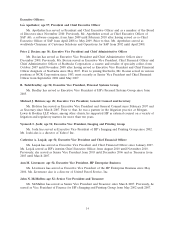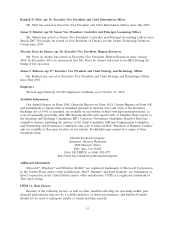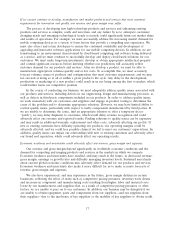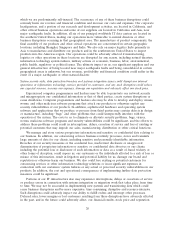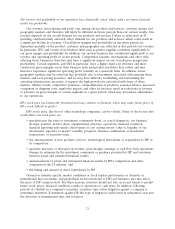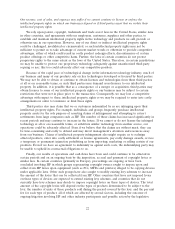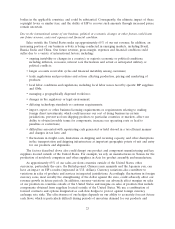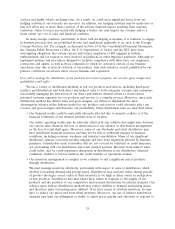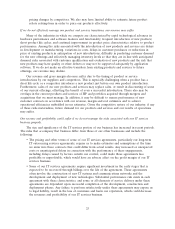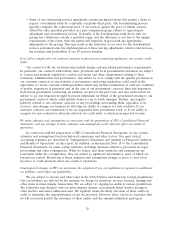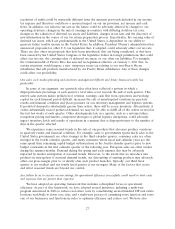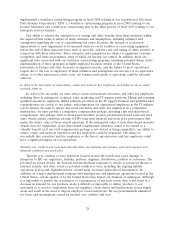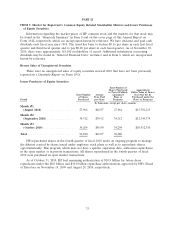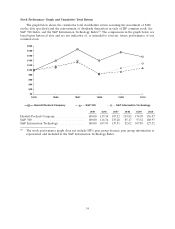HP 2010 Annual Report Download - page 32
Download and view the complete annual report
Please find page 32 of the 2010 HP annual report below. You can navigate through the pages in the report by either clicking on the pages listed below, or by using the keyword search tool below to find specific information within the annual report.services and highly volatile exchange rates. As a result, we could incur significant losses from our
hedging activities if our forecasts are incorrect. In addition, our hedging activities may be ineffective or
may not offset any or more than a portion of the adverse financial impact resulting from currency
variations. Gains or losses associated with hedging activities also may impact our revenue and to a
lesser extent our cost of sales and financial condition.
In many foreign countries, particularly in those with developing economies, it is common to engage
in business practices that are prohibited by laws and regulations applicable to us, such as the Foreign
Corrupt Practices Act. For example, as discussed in Note 18 to the Consolidated Financial Statements,
the German Public Prosecutor’s Office, the U.S. Department of Justice and the SEC have been
investigating allegations that certain current and former employees of HP engaged in bribery,
embezzlement and tax evasion or were involved in kickbacks or other improper payments. Although we
implement policies and procedures designed to facilitate compliance with these laws, our employees,
contractors and agents, as well as those companies to which we outsource certain of our business
operations, may take actions in violation of our policies. Any such violation, even if prohibited by our
policies, could have an adverse effect on our business and reputation.
If we fail to manage the distribution of our products and services properly, our revenue, gross margin and
profitability could suffer.
We use a variety of distribution methods to sell our products and services, including third-party
resellers and distributors and both direct and indirect sales to both enterprise accounts and consumers.
Successfully managing the interaction of our direct and indirect channel efforts to reach various
potential customer segments for our products and services is a complex process. Moreover, since each
distribution method has distinct risks and gross margins, our failure to implement the most
advantageous balance in the delivery model for our products and services could adversely affect our
revenue and gross margins and therefore our profitability. Other distribution risks are described below.
• Our financial results could be materially adversely affected due to channel conflicts or if the
financial conditions of our channel partners were to weaken.
Our future operating results may be adversely affected by any conflicts that might arise between
our various sales channels, the loss or deterioration of any alliance or distribution arrangement
or the loss of retail shelf space. Moreover, some of our wholesale and retail distributors may
have insufficient financial resources and may not be able to withstand changes in business
conditions, including economic weakness and industry consolidation. Many of our significant
distributors operate on narrow product margins and have been negatively affected by business
pressures. Considerable trade receivables that are not covered by collateral or credit insurance
are outstanding with our distribution and retail channel partners. Revenue from indirect sales
could suffer, and we could experience disruptions in distribution if our distributors’ financial
conditions, abilities to borrow funds in the credit markets or operations weaken.
• Our inventory management is complex as we continue to sell a significant mix of products
through distributors.
We must manage inventory effectively, particularly with respect to sales to distributors, which
involves forecasting demand and pricing issues. Distributors may increase orders during periods
of product shortages, cancel orders if their inventory is too high or delay orders in anticipation
of new products. Distributors also may adjust their orders in response to the supply of our
products and the products of our competitors and seasonal fluctuations in end-user demand. Our
reliance upon indirect distribution methods may reduce visibility to demand and pricing issues,
and therefore make forecasting more difficult. If we have excess or obsolete inventory, we may
have to reduce our prices and write down inventory. Moreover, our use of indirect distribution
channels may limit our willingness or ability to adjust prices quickly and otherwise to respond to
24


